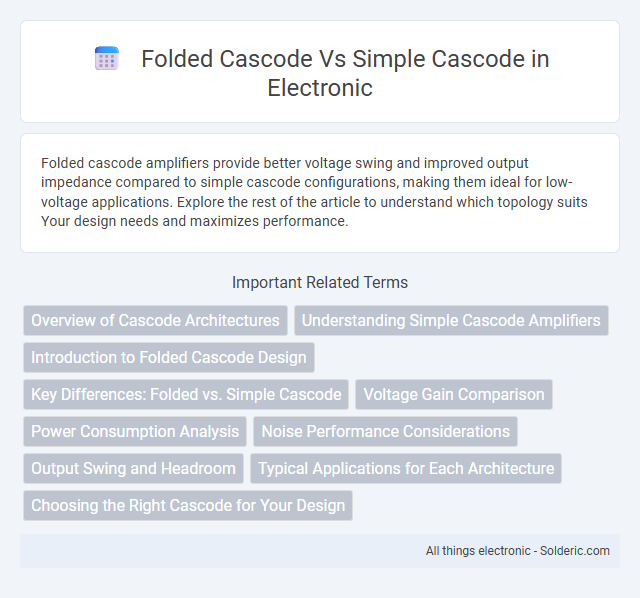Folded cascode amplifiers provide better voltage swing and improved output impedance compared to simple cascode configurations, making them ideal for low-voltage applications. Explore the rest of the article to understand which topology suits Your design needs and maximizes performance.
Comparison Table
| Feature | Folded Cascode | Simple Cascode |
|---|---|---|
| Topology | Transistors arranged in a folded configuration | Transistors stacked vertically in cascade |
| Voltage Headroom | Lower voltage headroom, suitable for low-voltage applications | Higher voltage headroom required |
| Gain | Moderate gain due to extra transistor stages | High gain from cascode transistor stacking |
| Bandwidth | Lower bandwidth due to increased parasitic capacitances | Higher bandwidth, better frequency response |
| Output Swing | Improved output swing in low-voltage scenarios | Limited output swing |
| Input Common-Mode Range | Wider input common-mode range | Narrow input common-mode range |
| Power Consumption | Higher power consumption due to additional devices | Lower power consumption |
| Complexity | More complex layout and design | Simpler design and easier implementation |
| Use Case | Low-voltage, low-power amplifiers with wider input range | High-gain, high-speed amplifiers requiring high headroom |
Overview of Cascode Architectures
Folded cascode and simple cascode architectures enhance amplifier gain and bandwidth by minimizing Miller effect capacitance and improving output impedance. Simple cascode configurations stack transistors vertically for high gain but suffer from limited voltage headroom, while folded cascode designs fold the transistor stages horizontally, enabling better voltage swing and lower power consumption in low-voltage applications. Both architectures are crucial in analog integrated circuits, with folded cascodes preferred for low-voltage operations and simple cascodes chosen for high-voltage and high-gain requirements.
Understanding Simple Cascode Amplifiers
Simple cascode amplifiers improve gain and bandwidth by stacking a common-emitter stage with a common-base stage, reducing the Miller effect and enhancing frequency response. In comparison to folded cascode circuits, simple cascodes provide higher gain with lower output impedance but may consume more voltage headroom, limiting output swing. Understanding simple cascode operation helps optimize your amplifier design for applications requiring high gain and moderate power consumption.
Introduction to Folded Cascode Design
Folded cascode design offers an effective alternative to simple cascode amplifiers by improving voltage gain and output swing while maintaining high input impedance. This topology folds the current path, allowing for lower supply voltages and enhanced frequency response compared to the traditional cascode structure. Your choice of folded cascode can optimize amplifier performance in low-voltage analog circuits, making it ideal for modern integrated circuit applications.
Key Differences: Folded vs. Simple Cascode
The folded cascode amplifier offers improved output voltage swing and better power supply rejection compared to the simple cascode by folding the current path through an additional transistor stage. Simple cascode configurations typically provide higher gain and faster bandwidth but with reduced output voltage headroom. Your choice depends on whether voltage swing or gain and speed are prioritized in the circuit design.
Voltage Gain Comparison
Folded cascode amplifiers typically exhibit lower voltage gain than simple cascode configurations due to their additional current folding stage, which introduces extra transistor gain stages and parasitic capacitances. Simple cascode amplifiers achieve higher intrinsic gain by stacking transistors in series, resulting in increased output impedance and improved voltage gain performance. Device parameters such as transconductance (gm) and output resistance (ro) directly influence these gain differences, with simple cascodes optimizing gain at the expense of higher voltage headroom requirements.
Power Consumption Analysis
Folded cascode amplifiers exhibit lower power consumption compared to simple cascode designs due to their ability to operate at reduced supply voltages and maintain high gain. The folded topology minimizes voltage headroom requirements, enabling the use of smaller bias currents and consequently lowering overall power dissipation. In contrast, simple cascode amplifiers often demand higher bias currents to sustain performance, resulting in increased power consumption under similar operating conditions.
Noise Performance Considerations
Folded cascode amplifiers exhibit lower input-referred noise compared to simple cascodes by distributing voltage swing and reducing transistor transconductance requirements, which minimizes thermal noise. Simple cascodes benefit from fewer devices and reduced parasitic capacitances, but often face higher noise due to increased current density and voltage stress on the input transistor. Design choices hinge on noise spectral density metrics, with folded cascodes preferred in low-noise analog front-ends demanding enhanced signal integrity.
Output Swing and Headroom
Folded cascode amplifiers provide greater output swing and improved headroom compared to simple cascode designs due to their ability to separate input and output voltage ranges through folding transistors. In simple cascodes, the stacked transistor structure limits output voltage swing as the output node must remain within the voltage range defined by the cascode transistor threshold voltages. The folded cascode topology reduces voltage headroom constraints by lowering the output node voltage relative to the supply, enabling enhanced dynamic range and signal fidelity in low-voltage analog circuits.
Typical Applications for Each Architecture
Folded cascode amplifiers are commonly used in low-voltage and low-power applications such as portable devices and battery-powered sensors due to their ability to operate efficiently at lower supply voltages. Simple cascode amplifiers find typical applications in high-frequency and high-gain circuits like RF amplifiers and operational amplifiers where their superior gain and bandwidth performance are critical. Your design choice depends on the trade-off between voltage headroom and gain requirements specific to your application.
Choosing the Right Cascode for Your Design
Choosing the right cascode amplifier depends on your design's voltage headroom and noise requirements. Folded cascode topology offers higher output voltage swing and better input-output isolation, making it ideal for low-voltage, low-noise applications. Simple cascodes, while providing higher gain and faster speed, require more voltage headroom, suitable for designs with ample supply voltage.
Folded cascode vs Simple cascode Infographic

 solderic.com
solderic.com